![]()
![]()
![]()
Use LEFT and RIGHT arrow keys to navigate between flashcards;
Use UP and DOWN arrow keys to flip the card;
H to show hint;
A reads text to speech;
57 Cards in this Set
- Front
- Back

Above is a slide of the cerebral cortex of a man at autopsy indicating his COD. Which of the following COULD NOT describe the individual that died?
|
JC virus was the source of the pathology
|
|
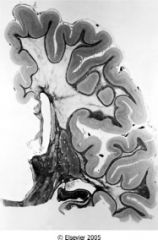
A 12 month old boy presents to the general pediatrics office with a decline in motor skills. He has not yet been able to walk, and his mother reports that the child is now struggling with rolling over, crawling, and sitting on his own. The infant had shown normal motor development until this visit. The pediatrician suspects a metabolic abnormality, and the picture below confirms the diagnosis. The child is expected to die within the next 5-10 years. (Metachromatic Leukodystrophy) What metabolic abnormality is associated with this diagnosis ?
|
Deficiency of the lysosomal enzyme arylsulfatase A
|
|

A 54-year old patient dies of complications of cirrhotic liver secondary to chronic alcoholism. Before his death, his family complained that he had begun having psychotic symptoms of progressing severity. Further, when he was hospitalized two weeks before his death, he appeared unable to move his eyes, but was otherwise responsive (although disoriented). On autopsy, coronal section of his brain revealed this lesion. What treatment may have helped to reverse this patient’s psychosis and opthalmoplegia?
|
Thiamine
|
|

A mother brings her 7 month old boy to your office. She says that he has been experiencing vision changes over the last few weeks. Additionally, over this time period, she has noticed other changes that may indicate motor and mental deterioration. Before this time, the child?s development was normal. On ophthalmologic inspection, you notice this: (Tay-Sachs Cherry spot). In describing this disease, you would be correct in saying that:
|
Both parents are carriers of the disease, which is characterized by a deficiency in hexoseaminidase A.
|
|
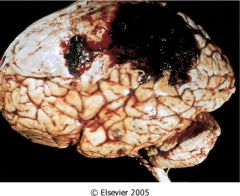
The type of lesion indicated would be most likely in which of the following patients?
|
A little league pitcher who was knocked unconscious by sharp blow to the head with fracture of the temporal bone
|
|
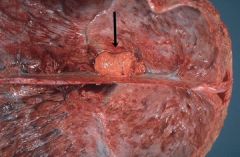
What are some of the histologic features of this CNS tumor? (meningioma)
|
Psammoma bodies, whorled nests of cells containing abundant pink cytoplasm.
|
|
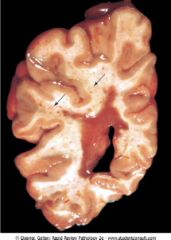
This patient presents with bilateral internuclear opthalmoplegia, cerbellar ataxia, and scanning speech. This pathology is associated with:
|
HLA-DR2
|
|
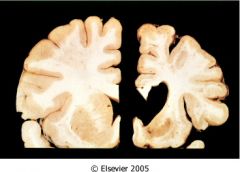
This autosomal dominant disorder in which there is loss of medium spiny striatal neurons is characterized clinically by:
|
Jerky, hyperkinetic , dystonic movements affecting all parts of the body and dementia
|
|
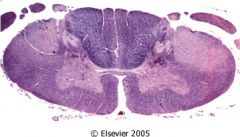
These lesions of the corticospinal tracts are associated with:
|
A mutation of the gene encoding zinc-copper superoxide dismutase on chromosome 21
|
|
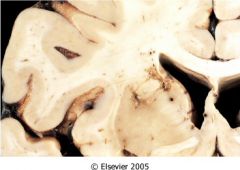
Which of the following is true about these infarcts?
|
They are cavities of tissue loss with surrounding gliosis (Lacunar Infarcts)
|
|
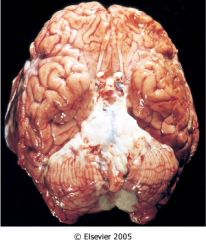
An organism responsible for the above pathology may also cause which of the following?
|
Adrenal Crisis (Pyogenic Meningitis)
|
|
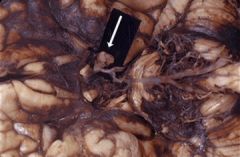
What inheritable disorder is not associated with this abnormality?
|
Tay Sach Disease (Berry Aneurysm)
|
|

What is the clinical course associated with this brain lesion?
|
One day after a minor fender bender a 65-year old male begins experiencing headache and confusion which subsided without medical intervention. Three months later the patient presents with seizure and gradually worsening contralateral weakness.
(Subdural hematoma) |
|

This lesion typically presents as obstructive hydrocephalus due to:
|
Expansive growth in the 4th ventricle (Ependymoma high power)
|
|
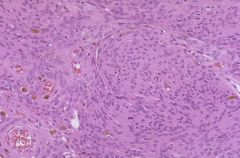
This slide shows a tumor often marked by:
|
Deletions of 22q12 (the NF2 gene) (Meningioma)
|
|
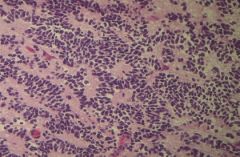
This tumor is marked by
|
Loss of a tumor suppressor from the short arm of chromosome 17 (Medulloblastoma)
|
|

A patient presenting to your office with this slide from the cerebral cortex, most likely presents with what disease?
|
AIDS (Toxoplasma gondii pseudocyst)
|
|
|
25 yo caucasian female comes in to see her primary care for recurrent abdominal pain. She rates the pain as 9/10, and says the attacks seem to happen after she's had a few beers. The physician notes that she may be showing early signs of dementia and some proximal weakness. The doctor asks for a urine sample, and she comments that her urine has been unusually clear. The physician thinks that the girl may have a/an ___ disorder that involves a deficiency in?
|
Autosomal dominant, porphobilinogen deaminase
|
|
|
A 12 year old autistic male presents to your office with hypopigmented leathery skin patches and a history of seizures. You diagnose him with tuberous sclerosis and are also concerned about which of the following:
|
Subependymal Hamaromas with "Candle-guttering"
|
|
|
A 15-year-old boy, cancer survivor after ALL at age 7 has been complaining of constant headaches. He has been having a tough time concentrating in school in the 10th grade. A head CT reveals a 5 cm cystic mass in the cerebellum. Neurosurgeons resect the mass and send them to pathology. Microscopically, the tumor has long thin"hairlike" processes that are GFAP-positive. In addition there are Rosenthal fibers, eosinophilic granular bodies, and microcysts. Which of the following is the most likely diagnosis?
|
pilocytic astrocytoma
|
|
|
A 20 month old child is struck in the side of the head while playing with his older brother. A head CT is obtained and reveals what seems to be a large intracranial bleed, but no skull fracture. The child loses consciousness, and a neurosurgeon is quickly called. The surgeon opens the child?s skull to relieve the increasing pressure. What is the most likely macroscopic appearance of the child?s brain.
|
a hematoma with a smooth inner contour compressing the brain
|
|
|
A 30 year old woman with a 5 year history of episodic blurry vision, muscle weakness, nystagmus, intention tremor, and scanning speech followed by periods of remission. Gross examination of brain would demonstrate demyelinating plaques in white matter. What is most likely associated with this disease process?
|
HLA DR2
|
|
|
A 35 year old caucasian female presents with a cheif complaint of fatigue and tingling in her left foot and left hand. Upon further questioning, she reveals that in the past year she has experienced similar tingling feelings in her other limbs as well as sensory loss, but these symptoms went away. Upon exam you notice she has a tremor in left hand and during the occular exam she claims that she has double vision when she moves her eyes laterally. What morphological changes would we expect to see with her condition?
|
plaques with lipid-filled macrophages and myelin breakdown in the white matter surrounding the ventricles
|
|
|
A 35 yo plant worker presents to his physician with complaints of chronic fatigue. His history is positive for morbid obesity for which he underwent an elective gastric bypass surgery 1 year ago. He has also been feeling lightheaded lately and has a tingling sensation in his lower extremities. He is currently on no medication. His lab work reveals an increase MCV. This patient is most likely suffering from...
|
B12 deficiency
|
|
|
A 50 year old man arrives unconscious at the ED. His wife called the ambulance after arriving home to find him lying on the floor. She tells the doctors that after a recent ice storm during which they lost power, he moved his generator into the attached garage so it wouldn't freeze. Which areas of the nervous system most likely have major damage?
|
Cerebral cortex layers III and V, Sommer sector of the hippocampus, and Purkinje cells
|
|
|
A 50 yo male stumbles into the hospital. He says he has been living in the park for the last 6 months, and smells strongly of body odor and alcohol. His physician notes the presence of opthalmoplegia, nystagmus, ataxia of gait and stance and derangement of mental function. The patient does not show evidence of retrograde memory impairment. In addition to chronic ethanol abuse, what nutrient deficiency is associated with Wernicke-Korsakoff syndrome.
|
Thiamine
|
|
|
A 53 year old man comes to your office because his hands keep ?cramping up?. A few weeks ago he noticed that his right hand kept ?giving out? and he would often drop his keys when he went to unlock the car. At first he dealt with this by using his other hand for carrying things ? but now he?s finding that he is losing the ability to do fine-motor tasks with his right hand, though his left hand is still only mildly affected. Which of the following is most likely to be seen in this disease process?
|
Reduction in number of anterior horn neurons throughout the length of the spinal cord
|
|
|
A 55 year old woman is discovered to have a 1cm parasagittal mass on CT. Which of the below is most likely.
|
histology demonstrates lamellated calcium concretions
|
|
|
A 56 yo male presents to the emergency room crying and speaking very slowly with some words missing, but appears alert, and has right leg hypothesia (decreased sensation) and paralysis after a transcontinental flight. The primary somatosensory and somatomotor cortices are both affected. He is obese, has a history of atherosclerosis, atrial fibrillation, and hypertension, and is a self-described desk-jockey. Which two artery anastomosis (watershed) is hypotensive to produce this combination of symptoms?
|
Anterior Cerebral Artery and Middle Cerebral Artery Junction
|
|
|
A 57 year old female presents to your office for FU after a seizure. She has no other complaints except occassional headaches. You see a mass on CT and order a biopsy which shows necrosis and endothelial cell proliferation. What else would you expect to see?
|
Pseudopalisading from necrosis and hypercellularity
|
|
|
A 57 year old male presents to your office with a history of personality changes, ataxia and blurred vision. He reports he has not seen a physician for nearly 15 years, when he had a "sore on his genitals." Upon physical examination, the pupils are miotic and fail to constrict further in response to light but do demonstrate normal constriction due to accommodation. The patient also has absent deep tendon reflexes and loss of vibration sense. Which of the following is TRUE about the patient's disease process?
|
These clinical findings are consistent with tabes dorsalis
|
|
|
A 62 year old man has reduced hearing for the last 6 months. Using your ITP skills, you obtain a thorough family history and learn that his mother also had hearing problems and spinal cord tumors. You order a CT scan of the head which demonstrates bilateral, well-circumscribed masses. On the right, there is a 4-cm mass adjacent to the right pons that extends toward the left inferior cerebellar hemisphere, and on the left there is a 3.5 cm mass at the cerebellar-pontine angle. You correctly determine that the patient has a disorder which mutations on which of the following chromosomes?
|
22q12
|
|
|
A 7 yo boy comes to you with CC of clumsy walk. A CT brain shows a solitary cerebellar mass. Biopsy reveals a mural cyst. Based upon the patient's age and diagnostic findings, what is the the most likely diagnosis?
|
Pilocytic Astrocytoma
|
|
|
A 72 yo white male presents to the ED complaining of an inability to move and feel his right arm. He is accompanied by his worried daughter who also reprots "excessive clumsiness while walking" that she noticed in him beginning two hours ago. The patient admits an attack of dizziness accompanied by the urge to vomit one hour ago. On physical exam, you notice absent tactile sensation in the distribution of the left trigeminal nerve. Lab work shows normal CSF protein and glucose levels. This patient's condition is most likely explained by:
|
Atherosclerotic stroke involving the vertebrobasilar arterial system
|
|
|
A group of infections passed from mother to unborn child in utero leads to similar clinical manifestations, including heart, skin, eye, and CNS involvement. The fetus may be microcephalic and demonstrate cerebral calcification. Which of the following infectious organisms is NOT part of this group?
|
E. Coli
|
|
|
A healthy 58 year old woman enters the ED with "the worst headache of her life." A CT scan reveals a deep, midline subarachnoid hemorrhage. Just before the patient loses consciousness, she tells you she has no history of hypertension and no one in her family has ever had a stroke. Which pathology is the most likely explanation?
|
Saccular (Berry) aneurysm
|
|
|
A homeless man is found on the sidewalk and later pronounced dead at the hospital. During the autopsy, Dr. Gunther notices there is bilateral postauricular hemorrahge This finding is most likely to suggest which one of the following?
|
basilar skull fracture caused by trauma and before the patient died he probably had CSF otorrhea
|
|
|
A previously healthy 19-year-old male college student presents to the ER complaining of headache and nausea. His roomate came home at noon from classes and noticed the patient lying in bed with the lights off, speaking incoherantly. In the ER The patient is still somewhat disoriented, has a fever, and is complaining of neck stiffness. You decide to do a lumbar puncture which reveals lymphocytic pleocytosis, moderate protein elevation, and a normal sugar content. Which of the following is the most likely consequence of this patient's illness?
|
The patient's illness will most likely resolve on its own without significant sequelae
|
|
|
A stubborn teenage male was often told by his extremely worrisome parents to refrain from certain activities that could possibly cause injury to his brain. Although he was alert immediately and 10 hours post injury, he presents at the ER 24 hours later with headaches and seizures. A head CT reveals an epidural hematoma under the left temple. Which of his parents' warnings did he most likely ignore?
|
Don't play baseball with your blind neighbor as the pitcher!
|
|
|
A tall, lean 27 year old female has just returned from the hospital following treatment of her subarachnoid bleed. Prior to this she has been in good health reporting only a past medical history of retinal detachment and mitral valve prolapse. Upon discharge her doctors advised her that she has a significantly increased risk of having a second subarachnoid bleed. Which of the following is the most likely cause of her current condition?
|
Saccular aneurysm bleed due to fibrillin-1 defect
|
|
|
Adequate levels of folate during pregnancy protect against the development of
|
Neural tube defects
|
|
|
Adrenoleukodystrophy is associated with all of the following except
|
Symptoms begin shortly after birth
|
|
|
All of the following are predisposing factors for the development of saccular aneurysms EXCEPT:
|
multiple sclerosis
|
|
|
All the following are true regarding progressive multifocal leukoencephalopathy (PML) except:
|
PML is caused by the Candida albicans
|
|
|
An 18mo adopted Filipino male is seen at his new pediatricians office with progressive loss of motor skills. He began walking at age 12, steady improvement in stability and ambulation, but now has progressive decline. The patient also has small testicles for his age, very bronze-colored skin, and hyponatremia. His parents tell the physician, ?he was a little slow to be able to walk.? The adoptive parents remember that the patient?s biologic mother had some similar, but less severe symptoms and had a brother that had died at 9 yo with a similar loss of ability to walk (X-linked) and hypotension (adrenal insufficiency). The parents also remember being told through a translator that the deceased brother had ?low blood? or hypotension. An MRI is ordered and shows bilateral symmetric demyelination. Match the disease with disorder.
|
Adrenoleukodystrophy: accumulated VLCFA in peroxisome leading to demyelination
|
|
|
Creutzfeldt-Jakob Disease, like other transmissible spongiform encephalopathies, is caused by abnormal:
|
beta-pleated prion protein (PrP)
|
|
|
Up to 60% of patients with AIDS develop neurologic symptoms, and 80-90% have neuropathologic changes. Any of the following syndromes may result from the direct or indirect effects of HIV-1 EXCEPT:
|
Subacute sclerosing panencephalitis resulting in cognitive decline, spasticity and seizures
|
|
|
Which latent infection is most likely to manifest in a patient with AIDS
|
Toxoplasmosis
|
|
|
Which of the following CNS tumors has multifocal areas of necrosis and cystic degeneration, commonly crosses the corpus callosum and may seed the neuraxis via the CSF?
|
Glioblastoma multiforme
|
|
|
Which of the following is a malignant small sell tumor that arises from the external granular cell layer of the cerebrum?
|
Medulloblastoma
|
|
|
Which of the following is a true statement?
|
VZV infection accounts for around 12% of all systemic herpesvirus infections in immunosuppressed patients with AIDS
|
|
|
Which of the following is not a symptom of progressive supranuclear palsy?
|
horizontal gaze palsy
|
|
|
Which of the following is NOT true concerning a dysembryoplastic neuroepithelial tumor?
|
bad prognosis, even after resection is performed.
|
|
|
Which of the following regarding rabies is true
|
The virus ascends in peripheral nerves
|
|
|
Which one of the following is a feature of Parkinson's Disease but is NOT a feature of Alzheimer Disease?
|
Tri-nucleotide repeat on chromosome 4
|
|
|
A 14 month old female has difficutly walking. She has muscle weakness and wasting. On examination she is determined to have myelin loss with an accumulation of sulfatides in multiple tissues. Identify the correct disease: deficiency combination for this case:
|
metachromic leukodystrophy arylsulfatase a
|
|
|
A 62-year-old black male presents to the ED with a 2-hour history of acute-onset headache, nausea, vomiting, and motor disturbances. Radiologic studies of the head show hemorrhage into the basal ganglia. In your work-up of this patient, which of the following would likely be abnormal?
|
vital signs
|

